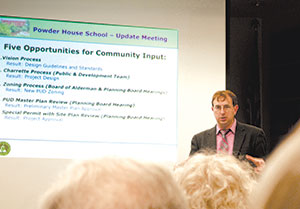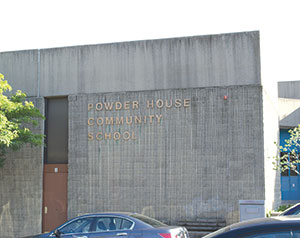
Somerville residents met last week to gather information and share their own ideas regarding the future development of the Powder House School site.
By Douglas Yu
A few blocks away from Davis Square Station on Holland St., one finds the back of Powder House Community School. One can hardly tell it’s an abandoned school until they see the schoolyard, which is now still being used as a practice field for a local bicycle riding school.
On July 21, the City of Somerville called upon its residents, mainly those who live in Ward 7 of Somerville, to come up with plans to redevelop this abandoned facility after the city ended negotiations with Tufts University on its redevelopment March this year, due to not committing to a timetable.
Most of the residents suggested the Powder House Community School should be used as affordable housing, since they felt that the neighborhood is being gentrified.
“Gentrification is not always inevitable; it’s a choice made by people,” one of the Somerville residents said. She said that the price of housing was rocketing in the last a couple of years, and providing more affordable housing was necessary to the renters.
 Another Somerville resident, who lives on Claremont St., wanted to see the best opportunity for working class families, moderate-income families, and the elderly. She learned from various community meetings that Somerville is losing a lot of working class families because of the high rental rates. “At least we can save some people from being displaced,” she said.
Another Somerville resident, who lives on Claremont St., wanted to see the best opportunity for working class families, moderate-income families, and the elderly. She learned from various community meetings that Somerville is losing a lot of working class families because of the high rental rates. “At least we can save some people from being displaced,” she said.
“In December of 2012, we issued the Request for Proposals (RFP) to find a developer partner to work on this. At the end of the day, we got six responses,” Director of Planning for the City of Somerville, George Proakis said. The majority of the School Committee chose Tufts University as a developer, which did not work out in the end.
The evaluation criteria form was handed out at the meeting to clarify what the qualifications of the final developer should be. The top evaluation criteria included the developer’s prior urban infill project experience, the development team member’s expertise with delivering the program and the design team’s prior experience with community engagement in design.
Proakis also highlighted some of the important ideas from the previous Powder House Community School meeting, and alluded to “…the 40 percent open space; maintaining access across the site to the TAB building for access to Holland Street; the general total allowed development size and the allowed use program. Also, there is an idea of a range of solutions to address the building type and commitment to collect tax on the full value of the project, regardless of the user.”
Proakis mentioned that when the city allowed Tufts to develop the facility, they had to agree to pay the property tax. So do the future developers.
Steven Santosuosso, who lives on the border of Medford, said he loves the idea of arts and maker community in Somerville. “We also like the idea of diversification of units, two to three bedroom units, as well as affordable housing,” Santosuosso said.
Somerville residents spent the most of time at the meeting grouping up with people who live in the same part of Somerville, discussing feasible solutions for the Powder House Community School development.
Somerville native Brenda McDonagh, who was in the same group with Santosuosso, suggested that the ground floor of the building could be used for multiple functions, such as community center and maker space.
 “We don’t want to see the developer put in a one big residential tower,” McDonagh said. “Also, Somerville is a neighborhood of high renters. So everybody who knows someone is renting, and therefore knows someone who is being priced out.”
“We don’t want to see the developer put in a one big residential tower,” McDonagh said. “Also, Somerville is a neighborhood of high renters. So everybody who knows someone is renting, and therefore knows someone who is being priced out.”
There were also voices from the art community at the meeting. Somerville artist Brad Johnson expressed his interest in transforming the school into an art studio.
“I don’t want it to be a large institution,” said Johnson, who lives on Paulina St. “If there is an institution, we’ll get loading trucks that will make a lot of noise. Otherwise, it’ll be quiet for the residents on Paulina Street.”
During the testimony, one of the resident’s representatives brought up that in addition to art uses, combining arts space and residential space to benefit the community was another strong idea. Applause hailed across the meeting when the other representative highlighted the need for transparency of the committee to “make sure people who have ulterior motive are not voting on this project.”
Proakis said he was going to sort through all the feedback from the residents and present a summarized version of all the ideas at the next meeting. “I want everyone to be on an even playing field, so they are all bidding on the scene,” Proakis said.

— Photos by Douglas Yu















Reader Comments